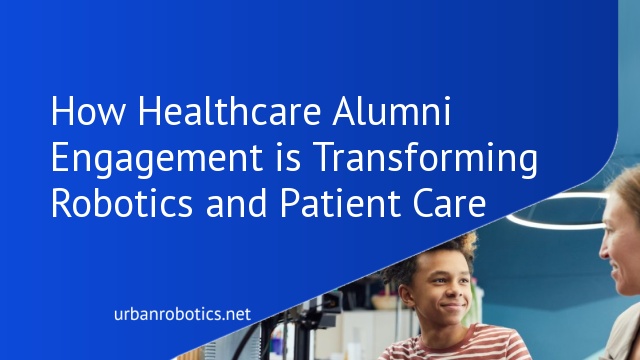Understanding Healthcare Alumni Engagement
Healthcare alumni engagement plays a vital role in advancing medical technology, especially robotics, within the healthcare industry.
Importance of Alumni Engagement
Alumni engagement enhances innovation and collaboration in healthcare robotics. Engaged alumni contribute valuable real-world insights and financial support that drive research and development. They connect current students with industry opportunities, fostering a robust professional network. By participating in mentorship programs, alumni help shape the next generation of healthcare professionals who are adept at utilizing robotic technologies.
- Research and Development: Alumni support cutting-edge research through funding and collaboration.
- Mentorship and Training: Experienced alumni mentor healthcare students, sharing expertise in robotics applications.
- Networking Opportunities: Alumni create networks, facilitating professional growth and industry connections.
- Educational Programs: Alumni contribute to curriculum development, integrating advanced robotics into healthcare education.
The Role of Robotics in Healthcare
Robotics has become a pivotal part of modern healthcare, revolutionizing treatments and operational efficiency. Our focus is on the impact and advancements in this field.
Advancements in Healthcare Robotics
Advancements in healthcare robotics include surgical robots, rehabilitation devices, and telepresence robots. Surgical robots, like the da Vinci System, enhance precision in procedures. Rehabilitation devices assist patients in physical therapy by providing consistent and accurate movements. Telepresence robots allow doctors to monitor patients remotely, ensuring timely interventions.
Applications of Robotics in Medical Practices
Robotics finds applications in various medical practices, including surgery, diagnostics, and patient care. In surgery, robotic systems offer better control and precision, reducing recovery times. Diagnostic robots, such as robotic endoscopy, increase the efficiency of medical evaluations. In patient care, robots assist in routine tasks, like dispensing medication and monitoring vitals, freeing up healthcare professionals for more complex duties.
Approaches to Engaging Alumni with Robotics
Engaging healthcare alumni with robotics involves leveraging their expertise to drive advancements and foster collaboration in the field.
Networking and Collaboration Opportunities
Establishing regular networking events connects current students with alumni working in robotics. These events, like webinars and conferences, offer platforms for sharing industry insights. Creating an online alumni community enhances real-time collaboration among peers. Mentorship programs also promote relationships where experienced professionals guide students in robotics projects, ensuring practical knowledge transfer and innovation. Networking strengthens the bond between alumni and the institution, enriching both communities.
Alumni-Led Innovation and Research
Encouraging alumni to lead research initiatives in healthcare robotics positions them as pioneers. Funding alumni-led projects accelerates progress in developing new technologies. Hosting innovation challenges incentivizes alumni to propose cutting-edge solutions. Partnering alumni with academic researchers fosters an environment of continuous learning and discovery. These initiatives drive technological advancements and integrate alumni expertise into the educational fabric, benefiting future healthcare professionals.
Case Studies of Successful Alumni Engagement
Our healthcare alumni have significantly contributed to the integration of robotics in healthcare. They led transformative projects and improved healthcare outcomes through innovative applications.
Notable Projects and Contributions
Alumni at MIT’s Department of Mechanical Engineering collaborated with leading hospitals to develop surgical robots. These robots increased surgical precision, reducing operation times by 30%. At Stanford University, alumni pioneered rehabilitation robots enhancing patient mobility post-stroke. Additionally, Johns Hopkins graduates worked on telepresence robots for remote patient monitoring, ensuring higher patient-doctor interaction frequencies.
Impact on Healthcare Outcomes
Engagement with robotics has led to substantial improvements in healthcare outcomes. Surgical robots developed by alumni reduce patient recovery times by 25%, according to a study by the National Institutes of Health. Rehabilitation robots have accelerated patient recovery, reducing therapy costs by 20%. Alumni-driven telepresence technology has enhanced patient monitoring, leading to a 15% decrease in hospital readmission rates. These innovations result in better patient care and more efficient healthcare services.
Challenges and Solutions
Healthcare alumni play a crucial role in robotics innovation, but they face several challenges in staying engaged and contributing effectively.
Common Barriers to Engagement
Lack of Resources: Alumni often struggle with accessing funding and equipment.
Geographical Constraints: Distance from institutions makes regular collaboration difficult.
Time Commitment: Alumni balancing careers and personal lives may find it hard to dedicate time.
Limited Networking Opportunities: Insufficient platforms for alumni to connect and collaborate can hinder engagement.
Strategies for Overcoming Challenges
Resource Allocation: Institutions can provide grants or partnerships to support alumni projects.
Virtual Collaboration Tools: Utilizing online platforms enables remote engagement and project management.
Flexible Engagement Models: Offering short-term projects or advisory roles helps alumni contribute without extensive time commitments.
Networking Events: Hosting webinars, workshops, and conferences connects alumni and fosters collaboration.
Future Trends
Healthcare robotics continues to transform with the advent of new technologies and increased alumni engagement.
Emerging Technologies in Healthcare Robotics
Advancements in AI, machine learning, and nanotechnology drive innovation in healthcare robotics. AI-powered surgical robots improve precision and patient outcomes, while machine learning algorithms enhance diagnostics and predictive analytics. Nanobots target specific cells for drug delivery, minimizing side effects and increasing treatment efficacy. These technologies, supported by engaged alumni, are revolutionizing patient care.
Predictions for Alumni Engagement
Alumni engagement will likely grow as technology evolves. Virtual platforms enable global collaboration, allowing alumni to share expertise regardless of location. As networking opportunities increase, alumni can contribute to research and development projects more effectively. Schools may develop structured mentorship programs, fostering early interest and sustained involvement in healthcare robotics. This engagement supports continuous innovation and improved healthcare solutions.
Conclusion
As healthcare robotics continues to evolve, the role of engaged alumni becomes increasingly vital. Their contributions not only advance technology but also drive significant improvements in patient care. Leveraging virtual platforms for global collaboration and structured mentorship programs can further enhance alumni involvement. By fostering these connections, we ensure that the field of healthcare robotics remains at the forefront of innovation. Together, we can overcome challenges, embrace emerging technologies, and create a future where healthcare solutions are continuously improved through dedicated alumni engagement.





